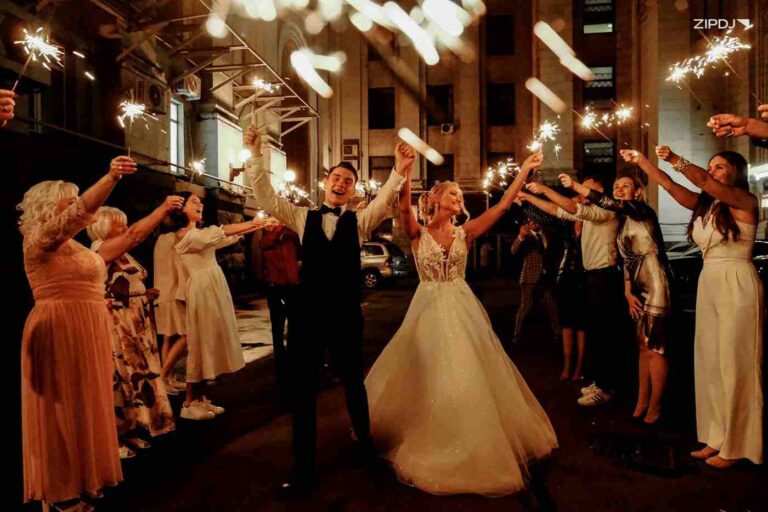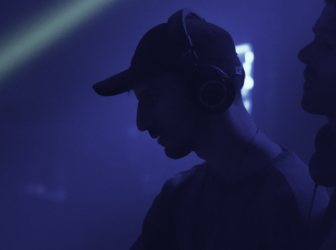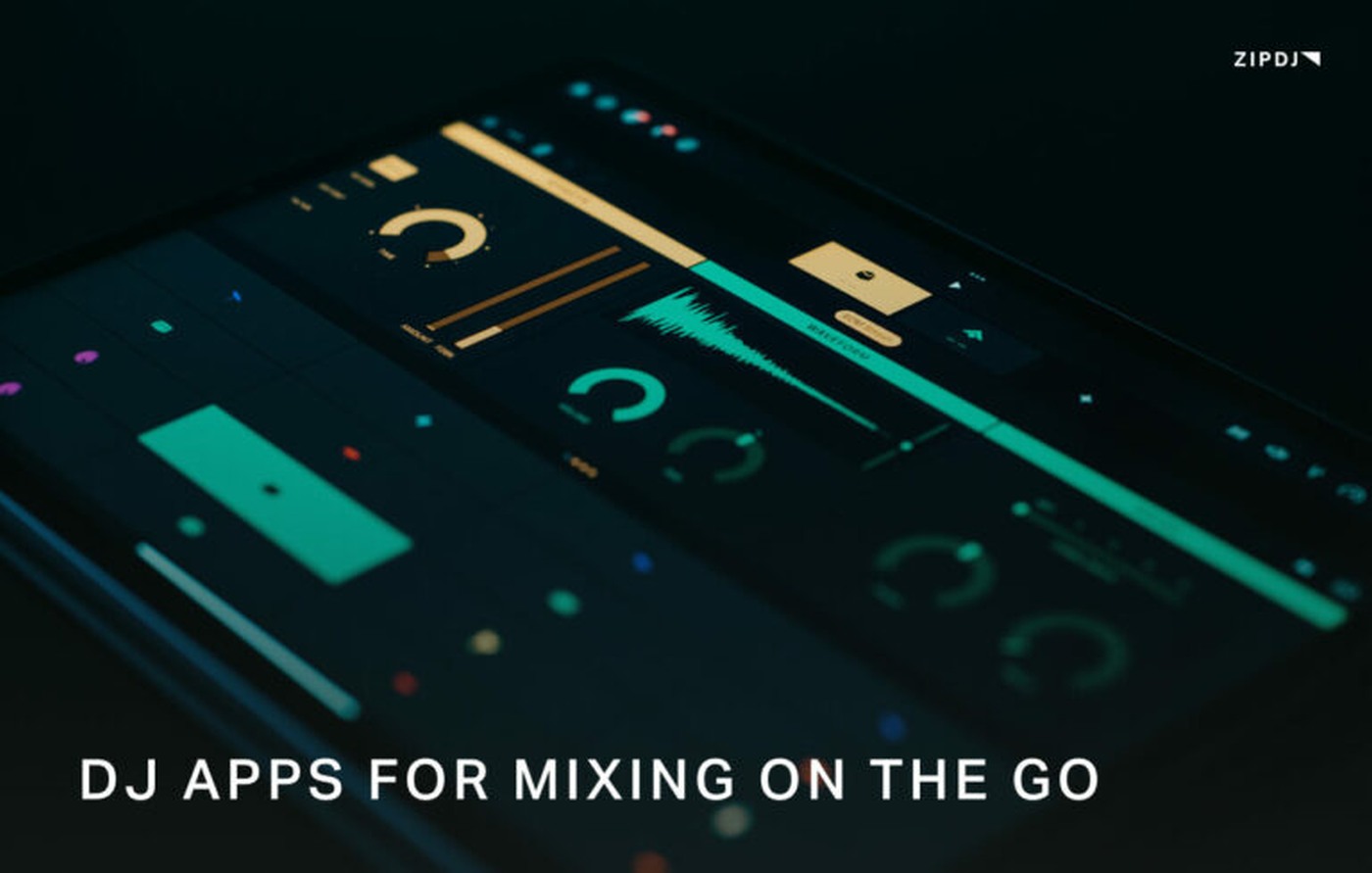How To DJ A Wedding: 10 Steps To Success

Learning how to DJ a wedding requires understanding a wide range of factors, from knowing where to access the best music libraries to dealing with clients and venue managers.
DJing weddings can be stressful, taking the traditional club DJ well out of their comfort zone and requiring them to act as a host and announcer as well as a DJ.
Fear not, as we’ve put together this complete guide to DJing weddings so you can choose the gear, resources, and mindset to deliver memorable sets.

How To DJ A Wedding In 2025 (Step-By-Step)
With many factors to consider when becoming a wedding DJ, it can be easy to get overwhelmed and fail to live up to the bride and groom’s expectations.
This step-by-step guide covers everything you need to know when planning and performing at weddings to guarantee the best results.
Read on and find out how to DJ a wedding with this complete step-by-step guide:
Step 1: Choose The Right Equipment
A good DJ is nothing without the right equipment, so making sure you have the correct DJ gear and accessories is the first step you need to take before getting started.
While some wedding reception venues will have equipment installed you can use, researching and investing in your own gear allows you to practice playing songs before the event to hone your skills.
Spend time researching the best DJ controllers and sound equipment available, investing the time to master the gear so you’re comfortable using it in front of an audience.
Depending on the venue, you may need to invest in a DJ booth set-up and a pair of DJ speakers before you can start DJing weddings professionally.
You should also consider what additional peripherals you might require. For example, if you’re planning on making announcements or introducing karaoke to the evening, you’ll need a decent microphone.
Finally, pack your kit with additional extension cables and any spare gear you might need in case of unforeseen equipment failures during the event.
It’s always better to be over-prepared and have a backup plan, even if that means exploring how to DJ with Spotify or switching to an old laptop.
Step 2: Meet With The Bride And Groom
While the best house music DJs have the luxury of complete control over the music they play, wedding DJs need to tailor their sets to the requirements of their clients.
This means meeting the bride and groom before the event to discuss what music they want to include at their wedding reception and the specific songs to play at key moments.
Meeting with the couple is also important in determining how much the wedding DJ charges and working out their budget and expectations for the big day.
As such, successful wedding DJs must have strong communication skills, clarifying their client’s wishes and giving them realistic expectations for the reception following their wedding ceremony.
By discussing the line-up of music with the couple in advance, a wedding DJ can ensure complete transparency and deliver a great wedding party that guests will remember long after the last song has played.
Step 3: Compile Your Music Library
Great wedding DJs understand the necessity of compiling a music library that caters to a broad range of tastes, with a particular emphasis on popular songs from famous singers.
This means putting together a playlist that covers all the crowd-pleasing hits typically played at a wedding to draw as many people onto the dance floor as possible.
Guests of all ages typically attend a wedding ceremony, so filling your digital crates with nothing but dance music is a surefire way to find yourself bombarded with song requests.
Finding common ground between a six and 80-year-old is a tall order, but many hit songs featuring acts from different eras can be played to bridge the generation gap on the dance floor.
Make sure you have any songs the bride and groom request lined up for the key moments in the event, such as the first dance of the evening and a selection of slow songs for when the night begins to wind down.
If you don’t already have a library of music you can use, signing up for a DJ pool will give you access to a large selection of music covering a broad selection of genres.
While having a complete archive of classic tracks at your disposal is impossible, a good wedding DJ will understand when songs work and play music familiar to the guests.
Step 4: Dress To Impress
Learning how to DJ a wedding is about more than just knowing which songs to play and when; all the songs in the world won’t matter if you turn up at the venue in sloppy attire.
Wedding DJing is about enhancing the big day’s experience, ensuring you’ve dressed appropriately in a suit or vest jacket and bow tie.
If you don’t have any smart clothes in your closet, you can hire them in advance for the event – remember to factor this cost into your overall budget before you bill the clients.
Those hoping to start a DJ business would be better off investing in a suit since the overall cost per wear will work out much cheaper over time, and they can tailor the suit for a better fit.
Step 5: Check Out The Venue
No two wedding reception venues are the same, and visiting these before the event is crucial for understanding what limitations you might face when performing your set.
If they have their own equipment, you’ll need to check if it’s up to scratch to meet your requirements or whether you’ll need to bring your own rig in on the night.
Make sure you speak to the venue owner to cover any specific factors, such as the use of smoke machines so that you’re fully aware of any dos and don’ts you need to know.
Venues that don’t feature in-house DJing equipment will need enough space for your own set-up, so make sure you know where the electric sockets are and where your DJ gear will be placed.
It’s also worth paying attention to the lighting; while it’s unlikely you’ll be able to compete with the best DJ visuals of all time, most venues will have disco lights to enhance your performance.
Lastly, you should find out where significant guests, such as those delivering speeches and the bridal party, will be seated to ensure your microphone cable has enough reach.

Step 6: Be Clear On The Timeline
A wedding is a meticulously planned event that is life-changing for the bride and groom, and a good DJ understands the importance of sticking to the plan.
Most DJs will request a copy of the wedding planner before the event so they know exactly what cues to expect throughout the evening.
In addition to the first dance and the slow dance that wraps up the evening, key moments such as cake cutting and speeches from the best man and other guests must be considered.
Once the timeline is established, many DJs use this to break the evening into themed segments, with playlists for background music as guests arrive and other key moments.
Once you’re clear on the timeline, you’ll know when to defer to the bride and groom’s requests and when you have more room to show off your DJ techniques and get the crowd dancing.
Step 7: Be Prepared For Song Requests
While many DJs prefer to control the music they play entirely, this isn’t something a wedding DJ can take for granted, and you need to anticipate many song requests from the guests.
It’s not uncommon for guests to frequently ask DJs to play requests, so it’s a good idea to mix with easy DJ transitions and basic beat matching rather than more complicated techniques that demand more attention.
Inevitably, you’ll develop strategies to dodge bad requests while accommodating the occasional song that might work on the dance floor.
A good technique for being approachable while screening requests is to have a notepad and pen with you, which guests can use to write down requests for you to consider.
There are also request-based apps available that guests can use to send their song suggestions to you from their mobile phones, such as RequestBox, YoDJ, and others.
This means you can pick those requests that fit into your playlists without having to quickly take the next track out of the queue at the last minute.
Ultimately, if you’re doing your job correctly and reading the crowd, they’ll be happy to dance to your chosen music, and the number of requests pouring in will be limited.
Step 8: Make The Most Of The Mic
Great wedding DJing isn’t just about playing songs that create a party atmosphere and encourage dancing; it also requires you to serve as a host.
This means making the most of your microphone, both as a tool to encourage people to hit the dance floor and as a method for the bride, groom, and others to deliver speeches.
Many DJs used to performing in clubs are wary of using microphones and talking over a song, but throw in a few jokes and some self-deprecating humor, and it becomes a great way to inject some fun into the evening.
At the same time, don’t overdo it; most people at a wedding would prefer to hear music than the sound of your voice, so use the mic to punctuate key moments in the evening.
It’s also handy for making announcements, letting guests know when the cake will be cut, when the last song is about to start, and other moments from the wedding planner.
Make sure you conduct a mic check before the event begins, as there are few things more irritating to the clients than no one being able to hear the best man deliver his speech.
Step 9: Suggest Including Karaoke
If you’re using a microphone and are looking for another way to make your weddings memorable, you can suggest including karaoke as part of the evening’s entertainment.
Karaoke is a fun way to ramp up the party vibe and encourage people to get more involved in the music, showing off their singing talent.
While karaoke and the DJing world are typically at odds with one another, a wedding reception offers a unique opportunity for people to interact and sing their favorite songs.
When building your archive of music to use, stack your playlist with plenty of songs everyone knows, and consider sharing a list of music available for anyone who wants to try their hand at karaoke.
Of course, handing over the microphone to a drunken guest isn’t the best idea, but you can use your judgment and make sure those participating are doing so in a good-natured manner.
Karaoke isn’t going to dominate the entire wedding schedule, but if the bride and groom think this will make their day more fun, it’s an excellent way to break up your set.
Step 10: Pay Attention To The Bride
The role of any good DJ is to read the room, understand when people are enjoying the music, and take them on a sonic journey that encompasses different moods and energy.
When playing at weddings, ensuring the bride enjoys the music is a top priority since this day is dedicated to her more than anyone else.
If the bride isn’t getting into the music and looks bored, it doesn’t matter how many other people are filling the dance floor.
The best way to avoid this unpleasant dilemma is to pay close attention to her feedback during the pre-event meeting, get a clear idea of her taste in music, and note down any specific requests.
If your off-the-cuff choice in music isn’t cutting it, you can then fall back on the notes you took during the meeting to select songs from artists you know she loves.
Summary
That concludes this comprehensive step-by-step guide exploring how to DJ a wedding, from the most effective ways to plan ahead to building a reliable archive of music.
DJing at weddings is a great way to develop new skills and communication techniques and build a reputation with hundreds of potential new clients.
Whether you’re starting a new business as a mobile DJ and want to include weddings in your list of services or are an established DJ looking for new ideas, this guide has got you covered.
Unlock an extensive music archive by signing up to ZIPDJ, and gain access to various genres you can use for your next wedding gig.
Not a member ?
Join Today for Unlimited Music Downloads. Visit zipdj.com for more information.



